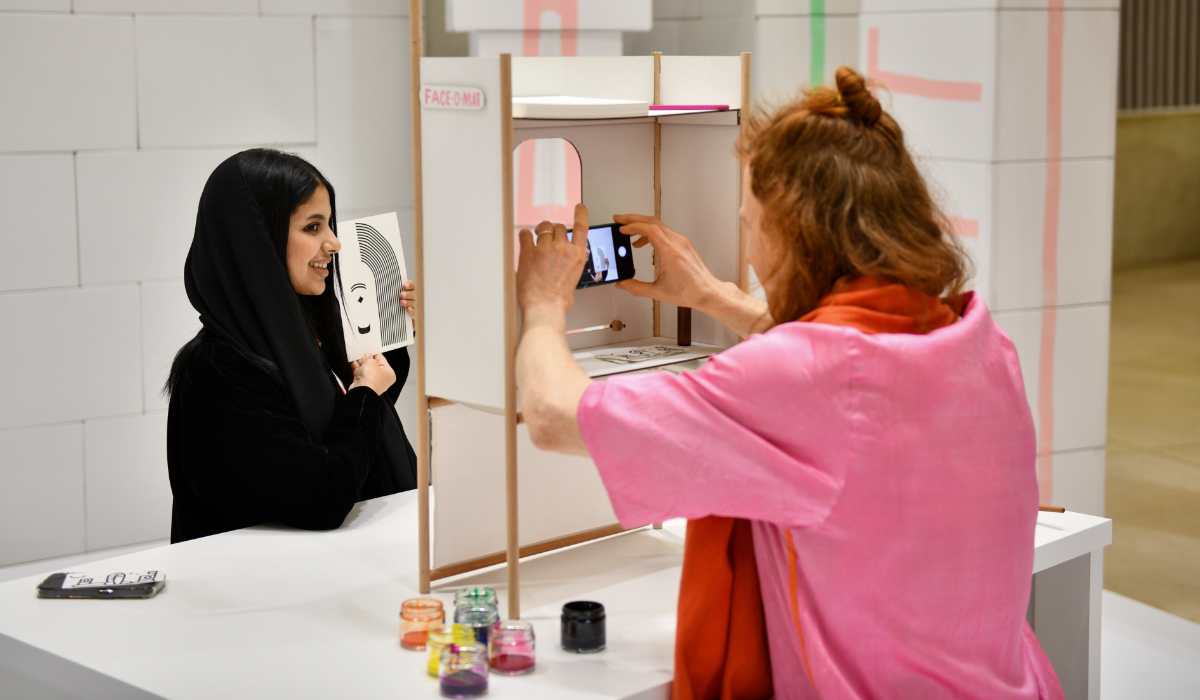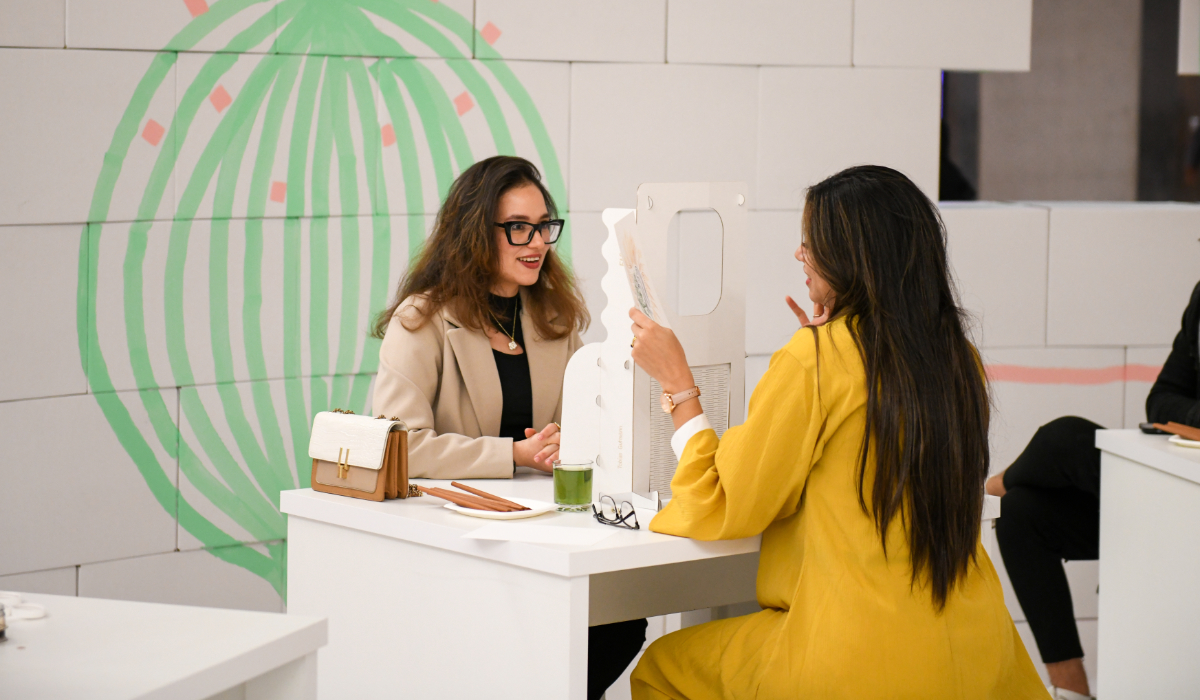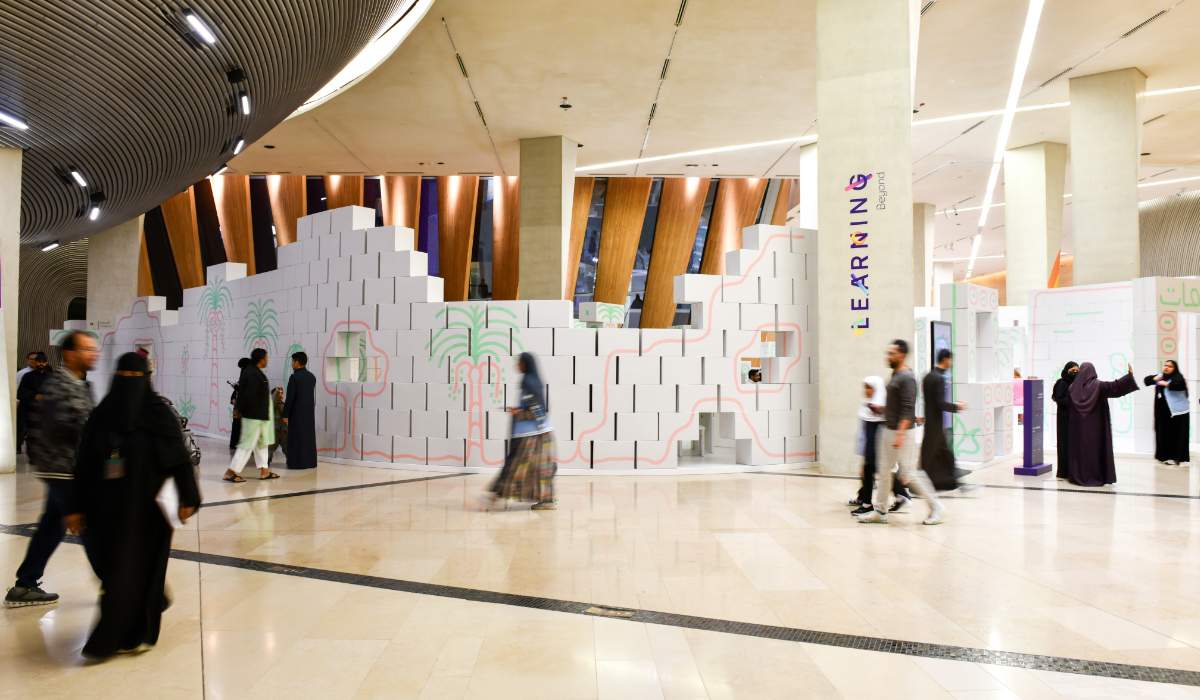DHAHRAN: If you visited the King Abdulaziz Center for World Culture, or Ithra, during the Beyond Learning Conference this week, you might have seen Swiss-German artist Tobias Gutmann seated at his Face-O-Mat installation, creating abstract interpretations of strangers’ faces using ink and paper.
“With my project, Face-O-Mat, I look into people’s faces. It takes courage to look into someone’s eyes or let someone look into my eyes,” Gutmann said. “How would our world look like if we would take the time to connect through conscious everyday face-to-face encounters?”
Born in 1987 in Wewak, Papua New Guinea, to Swiss-German parents, and having moved to Switzerland at 13, the now 36-year-old Gutmann learned early on that no matter where he was in the world, he could communicate through art.

A participant shows off her drawing at the Face-O-Mat atelier. (Supplied)
The idea of Face-O-Mat was born in Stockholm as part of a class project in one of his two MFA programs. Through deliberate strokes made using a tool resembling a mini rake, Gutmann symbolizes facial features while fully utilizing the negative space on the page.
Once you decide to participate, you sit on a small table facing Gutmann. A cardboard box with a hole in it sits between you two. Some of his “collaborators” speak; others remain silent and let their eyes do the talking. Some stare at him and hold his gaze, while some shyly look away. The main language is the pen, the ink, and the individual’s face.
Since it takes about five minutes to create each drawing, it is a slower process than snapping a photograph.
How would our world look like if we would take the time to connect through conscious everyday face-to-face encounters?
Tobias Gutmann, Swiss-German artist
Gutmann captures a moment by crafting a tangible artwork that holds his interpretation of the expression on a person’s face. The drawings are saddled between playfulness and steady squiggly shapes that represent a person’s features and characteristics. He accents them with a touch of color, such as a splash of red to represent a vibrant lipstick or a dot to show the eye color.
It is estimated that over the years, Gutmann has gazed into the faces of over 5,000 people to draw abstract interpretations of what he sees as he looks into their eyes. Since this project began, he has gained international recognition by providing the Face-O-Mat experiences globally in places such as France, Hong Kong, the US, Portugal, Switzerland, and now, Saudi Arabia.
The plants thriving at Ithra became an inspiration for installation, which was set up with the help of two Saudi artists to help him construct his “garden.”

Gutmann captures a moment by crafting a tangible artwork that holds his interpretation of the expression on a person’s face. (Supplied)
In a statement, Ithra wrote: “At the heart of Tobias Gutmann’s artistic practice lies the creation and investigation of encounters — between people, cultures and environments, but also between what we perceive on the outside and what we feel on the inside.”
Although Gutmann has done this numerous times, the Saudi experience had one unique addition. Cradled within the fortress made of boxes were a dozen tables set up with pieces of paper, paints, and his signature tool so that anyone passing through might attempt to make their own version.
“I made it quite intentional here because I didn’t want to be the European guy coming here and drawing the people … I felt like I want to take it a step further and actually let people draw each other,” he told Arab News.

Visitors to the Face-O-Mat atelier at Ithra are invited to draw each other. (Supplied)
“I wasn’t sure about the culture (in Saudi Arabia) … I wasn’t sure if everyone would actually sit down in front of me and I thought maybe they would sit down next to someone they know. That was the idea of actually creating this activity that could live without me being here.”
After each portrait is finished in the Face-O-Mat experience, he hands it to the person to keep but not before asking if he can snap a photo for his ever-growing digital archive.
One person who had his portrait created was Bader Al-Jenaid, who recently moved back to nearby Bahrain after completing an accounting internship in the UK. Considering a shift in his career to become a football coach and work with children, he stopped by the Ithra building for Beyond Learning to catch a few of the offerings — and to wait in the long line that snaked around the space to have his one-on-one time with Gutmann.

The Face-O-Mat atelier will remain at the Plaza in Ithra for the next two months. (Supplied)
“I’m a curious learner and I came into the Tobias Gutmann installation to get my picture drawn. I feel like the outcome I received made sense in a way … although it’s abstract, I can see myself in the portrait,” Al-Jenaid told Arab News.
While Gutmann was on hand at the center all week long, the father of two was eager to return to his wife and young children in Switzerland. He found his first time in the Kingdom to be filled with warmth and abundant in new Saudi faces he immortalized in ink.
The Face-O-Mat atelier will remain at the Plaza in Ithra for the next two months. People are invited to go there, dip into the ink, and draw what they see in each other to keep the non-verbal conversation going.
If you have had your portrait drawn by him, you are invited to join the thousands of others in his digital community. To scroll through the faces he has drawn, download the free Face-O-Mat app on your smartphone.


































